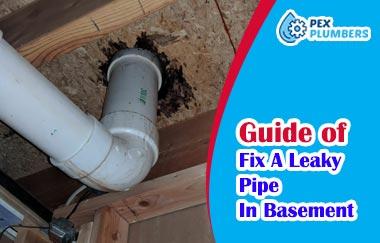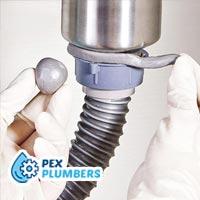Basement leaking pipes can skyrocket your utility bills and cause costly damages to your home and furniture items. You might even find still water in the basement that encourages foul odors and the growth of mold!

You don’t want any of that happening in your basement, so you need to fix leaks as soon as they appear.
The type of leak you’re dealing with will determine the method you use to fix it. If you find a leak at a joint, you may just need to tighten it.
Whereas if a leak seems to be on the pipe, you may need to cut out the leaking segment and replace it with a new one.
This article guides you on how to fix a leaky pipe in basement, plus helpful tips on what causes pipe leaks in the basement? to help you prevent them before they occur.
How To Fix A Leaky Pipe In Basement: Step By Step Guide

Just thinking about all the loss you could incur on your furniture and property for basement leaks is disturbing. It could also cause severe health conditions because it creates the necessary conditions for mold to grow in your basement.
Let’s look at how to fix a leaky pipe in the basement and avoid all these disasters.
Also You May Look: How To Find Broken Sprinkler Pipe Underground and Fix it?
1. Using Plumbers Epoxy Putty

Find the leaky section of the pipe. You will notice visible drops of water around the leaky pipe. Turn off the main water valve and use a rag to dry the leaky area.
Then, use sandpaper to smooth out any destruction or rust on the damaged pipe before cleaning and getting ready to apply the epoxy putty.
Epoxy putty is usually in two parts mixed to produce a reaction that creates the adhesive and toughening agents. Follow the package instructions on how to prepare it correctly. Don’t forget to put on latex gloves when handling the putty.
Once the putty is ready, apply it to the damaged basement pipe. And be sure to press it over the pipe leak to form a tight seal.
Allow the epoxy to dry for about an hour before turning the valve back on. Make sure that the putty remains in place and that you can’t detect any more leaks.
TIP: You may consider using a propane torch to heat up the pipe after drying it to help accelerate the curing/drying process of the epoxy. You may also consider wrapping up the repair area with duct tape.
2. Using Repair Clamps

The clamp used here is essentially a pre-rolled sheet of stainless steel with a rubber lining inside that is held in place with soldered bolts and nuts.
The clamp tensile force is transformed to direct pressure on the inner rubber layer, forming a secure seal around the leaky pipe.
To use a repair clamp to fix a leaky pipe, quickly place its rubber-lined part over the exact position where there’s a leak on the pipe before you tighten the screws and nuts that hold the clamp in place.
Once in place, tighten the screws and nuts of the pipe repair clamp. It will form a seal over the leaky area. A decent pipe repair clamp will last for many years if you use it properly.
3. Using Tape
You can also use tape to stop water from leaking from pipes in the basement. Depending on the pipe you’re working on, several kinds of tape, such as Teflon tape, duct tape, and electrical tape, could be effective at containing a minor leak.
The key to temporarily using tape to repair a leak is to make sure the leaky pipe is completely dry while taping, as it will help you create a good seal.
You should also completely compress the tape on the pipe to avoid water pockets forming inside your tape job. Please note that this method will only work on minor leaks, and you should not attempt to use it on significant leaks.
4. Using Coupling Connectors
Slip couplings are another effective way to fix a leak in your basement. They’re usually small, water-right connections and securely join two pieces of pipe to stop leaks.
If you go with this method, be sure to select a slip coupling that is appropriate for the size or type of your pipe.
Search for a slip coupling that is the same size as the pipe that needs to be repaired and is long enough to allow you to cut off the leaky part.
Before buying one, also ensure that it is made of the same material as the leaky pipe that you plan to repair, which could be PVC or copper.
Remember that these slip couplings offer a lasting solution for your leaky pipes and are also code compliant.
What Cause Basement Pipe Leaks?

Discovering a leaky pipe in the basement may take you ages. This is because most of your home piping system isn’t visible.
On the other hand, knowing the likely culprits for a leak will help in troubleshooting your pipe leaks.
Below, we take a look at some common causes of leaky pipes in the basement.
1. Rust or Corrosion
Rust and corrosion can eat away at your home’s pipes as it ages, eventually creating a hole for water to escape through.
2. Clogged Pipe Lines
Clogging may seem unthreatening but it can cause your pipes to overflow or even burst and create leaks.
3. Pipe Joints Damaged
Excessive temperatures and high water pressure can be tough on pipe connection points over time, causing them to degrade. If your pipes are making a ticking and banging noise, you may have joint problems.
4. Shoddy Pipe Laying
You might be surprised that the leak problems in your home are caused by improper pipe laying. The solution to this? Never let anyone but a professional plumber handle your home plumbing system.
FAQS
Now that you know how to go about plumbing leak repair, here are some frequently asked questions to help you understand more about fixing leaky pipes.
1. How do you seal a pipe through a basement wall?
The most effective way to seal a pipe through a basement wall is by using hydraulic cement. Simply press this cement tightly into the gap using a putty knife or a small trowel. Ensure the cement bonds with both the leaky pipe and the surrounding basement wall for a long-lasting seal.
2. Can you patch a leaking pipe?
Yes. The most convenient way to patch a leak is by using epoxy putty. Take a sufficient amount of epoxy, and work it with your hands until it’s combined and ready to apply. Shape the epoxy to cover the entire leak on the pipe, press it down to apply, and give it some time to dry.
3. Does leak seal tape work?
Yes. Pipe leak seal tape is an excellent do-it-yourself solution for several common plumbing issues. Replacing joint seals with tubing thread tape is perfect for keeping your plumbing in good working order.
Conclusion
If left unrepaired, dripping pipes in the basement can lead to massive water bills and water flooding on the basement floor, which promotes unwanted mold growth that’s harmful to your health and foul odors in your home.
It will also destroy your furniture and property. Preventing this type of damage isn’t always easy, so we recommend fixing a leak as soon as you discover it.
Following the simple tips and guidelines, we have shared on how to fix a leaky pipe in basement will save you money and the inconveniences that come with ignoring these leaks.
Whether you’re dealing with a minor or a bigger leak, the above methods will help you fix it on your own.
More Articles for Plumbing:
- Top 7 Types of Plumbing Traps
- Pick a Good Quality PEX Crimp Rings Form Our List
- Difference Between MAPP Gas or Propane
- Sanitary Tee Vs Wye: Which One is for You

Hey! I’m Leanda Bailey. I’m here to explain every plumbing installation and repair you may have in your kitchen or bathroom. Also, I’ll try to find you the best products on the market for your plumbing work.

